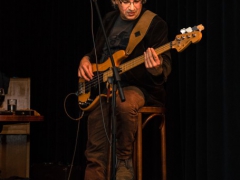 January 28th
January 28th
Summary
To introduce this Science Café session on “the Human Brain Project”, we started with a short movie to introduce this research project (available here). The optimist picture drawn in this movie was discussed this night by Prof. dr. Paul Tiesinga from Donders Institute Nijmegen and Prof. dr. Huib Mansvelder from VU Amsterdam, accompanied by the musical performance of the band Troubagroove.
The goal of the human brain project, explains prof. dr. Paul Tiesinga, is to put a brain into a computer. Not as a set of images (this has been done), but as a working computer simulation. A precursor of the project (the blue brain project) has already simulated 10,000 neurons, but for the entire brain billions of neurons have to be simulated, and to do so large investments are needed. Will it be a success? No, if we expect to create a conscious brain. Yes, if we expect to create the first infrastructure to simulate the brain and run this simulation. The objectives for the project are to improve our understanding of the brain and how brain diseases work, and to improve our computing technology. This technological improvement is necessary because our brain is much better at energy management than our current computers, with a factor 109. This means that to simulate the human brain with our current technology we would require a power supply of 9.4GW, a complete power plant, while our brain is using about 20W, the equivalent of a banana. In other words: there is a lot of improvement needed. To improve the technology we need to know how the connectivity and signal transmission between neurons work.
Prof. dr. Huib Mansvelder continues this thread by explaining his study of the functioning of neural circuits. A lot is published every year in the field of neurosciences, but it is very difficult to gather all this research and combine the knowledge. The human brain project can make this possible. Already a small trial has been done with simulating a mouse brain, but it is difficult to upscale this to the human brain, due to differences in brain structure. Human brain cells process more data and process it faster than mice. Studying how our brain cells behave while processing information will help to develop the computer equivalent for our neurons.
The Q&A brought us a nice discussion on the current state of simulation. At the moment a cat brain has been simulated, but the neurons in a cat brain are fairly simple. To translate ‘information’ into a pattern of firing neurons, experiments with information patterns (spikes) are needed, and to simulate these in a computer a lot of state and differential equations have to be integrated. Is it too early for such an enormous task? Not according to today’s lectors, the limiting factors are technology efficiency and our expectations. There is a race between complexity and technological advancement. Working on the Human Brain Project will speed-up this race, similar to the human genome project making DNA related research much faster and cheaper. But still many challenges lay ahead as we do not yet understand exactly how long term memory in the brain is organised.
We’re looking back at another interesting session of Science Café. Hopefully you will be there next time for the session on “Renewable Energy” with Niek Lopes Cardozo (TU/e, nuclear fusion) and John Schermer (RU Nijmegen, artificial photosynthesis). Join us the 31st of March!
Gallery
Photos courtesy of Tim Hofmeester








